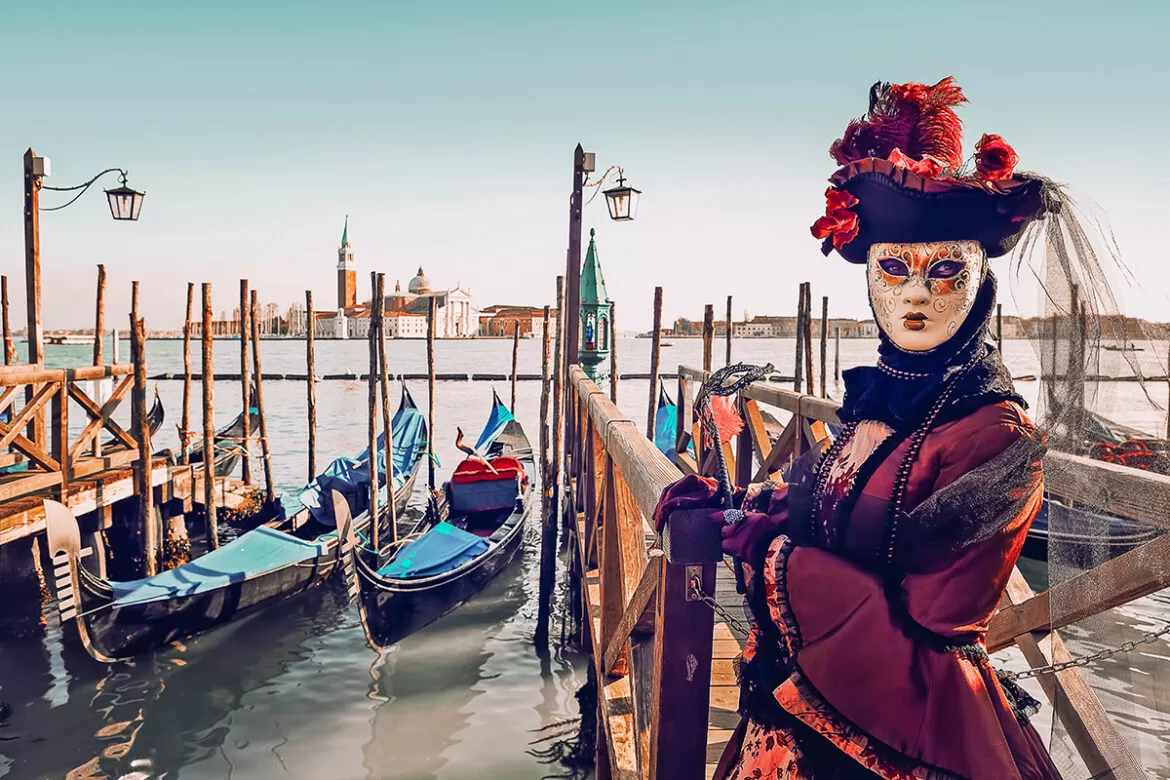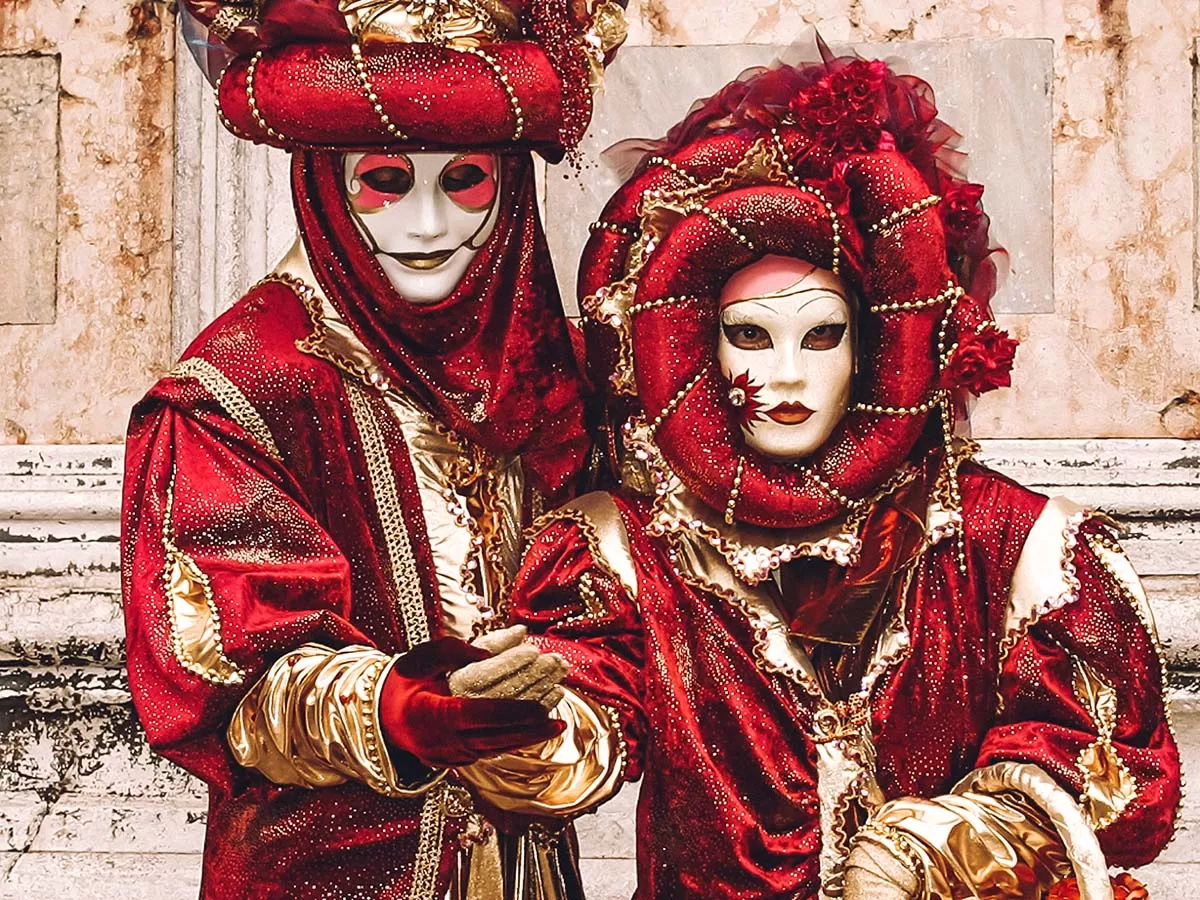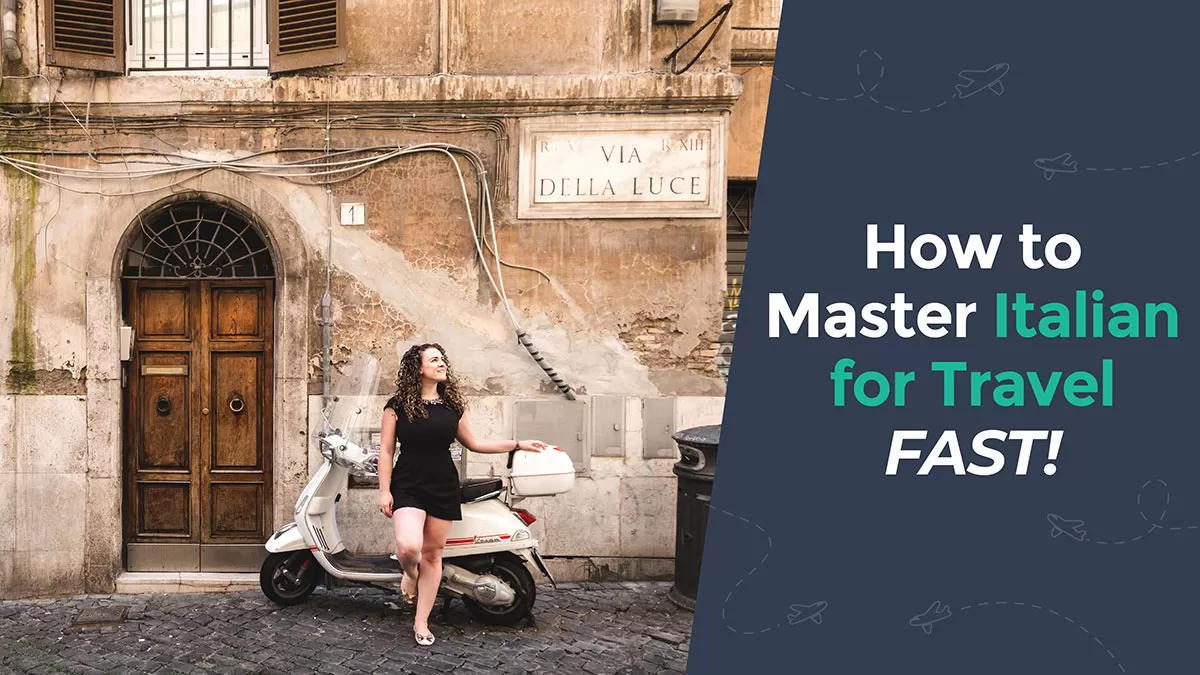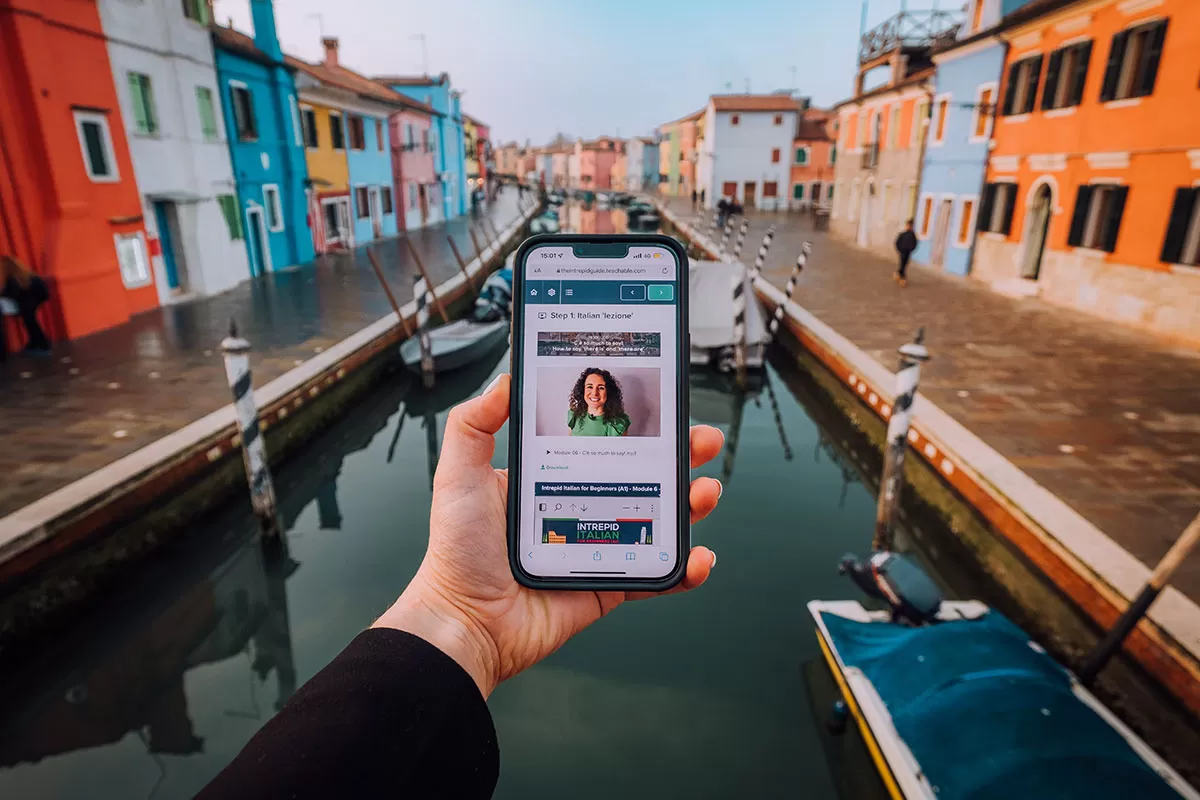Every year 3 million people flock to the Laguna to admire and take part in Venice Carnival, an iconic event whose origins are centuries old. There’s nowhere else in the world where you can soak up a truly unique scenery consisting of extravagant masks and costumes parading in the squares and calli (typical narrow Venetian streets). The wearing of masks is an ancient tradition that gives Venice Carnival a characteristic and lively atmosphere. Being in Venice for Carnival is a once in a lifetime opportunity that can’t be missed.
In this guide, you’ll learn everything you need to know about the Carnevale di Venezia (Carnival of Venice), from its origins, history and development to its modern-day version, from the traditional food and masks to the dates where the main events take place around the city. To exercise your Italian skills, we’ll finish up with a list of essential Carnival vocabulary. Don’t miss my Italian travel phrase guide here.
Cominciamo! (Let’s get started!)
History and development
So, what exactly is Carnival? The term derives from the Latin carnem levare, literally “to eliminate meat” or carne vale, “farewell to meat”, both referring to the farewell to meat and all bodily pleasures which is celebrated with a great banquet on “Shrove Tuesday”, the day before Lent (a period of abstinence and fasting) begins.
Incidentally, this is also how we get the verb to incarnate (Italian: incarnare), literally to embody the spirit/flesh of another. When we escape our reality and slip on a mask and costume, we are actually incarnating another person.
Its etymology points to a Christian origin of this holiday period: it refers to the annual Christian feast that involves a public celebration of some kind, typically with parades, parties or other forms of entertainment. Lent lasts for forty days and ends at Easter.
The Carnival tradition has very ancient origins: back in the Roman times, for instance, the “Saturnali” were a time of year when a joyous collective ritual was permitted and even encouraged, in which the rigid order between social classes was subverted.
In ancient Greece, there were Dionysian cults with great religious festivals, processions and theatrical performances involving the use of masks and symbolic representations.
However, guess where the word ‘Carnival’ appears for the first time? Venice! In a document by Doge (the Venetian term for “general”) Vitale Falier in 1094, the word Carnival is used to refer to public entertainment.
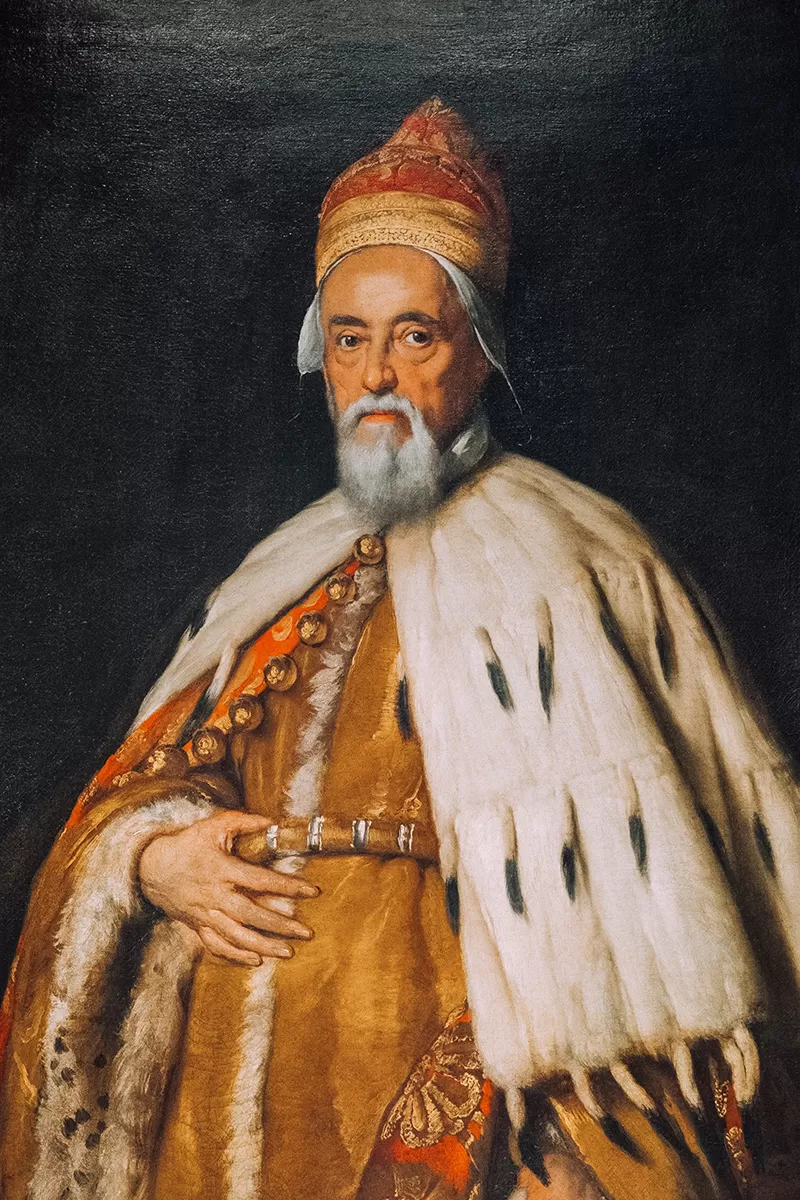
Doge of Venice
It’s important to know that isn’t wasn’t until 1296 that the Carnival in Venice became an official public holiday after an edict of the Senate of the Republic declared the day before “Ash Wednesday” (the beginning of Lent) a public holiday.
The Dogiwere adept at promoting the Carnival to give the population, particularly the lower classes, a period of fun and celebration. Its intention was to act as an outlet for the tensions and ill feelings created by the strict rules imposed by the morality and public order of the Venetian Republic.
Thanks to the wearing of masks, total anonymity was guaranteed. This created a sort of cancellation of social divisions and a way to hide differences between noble people and peasants.
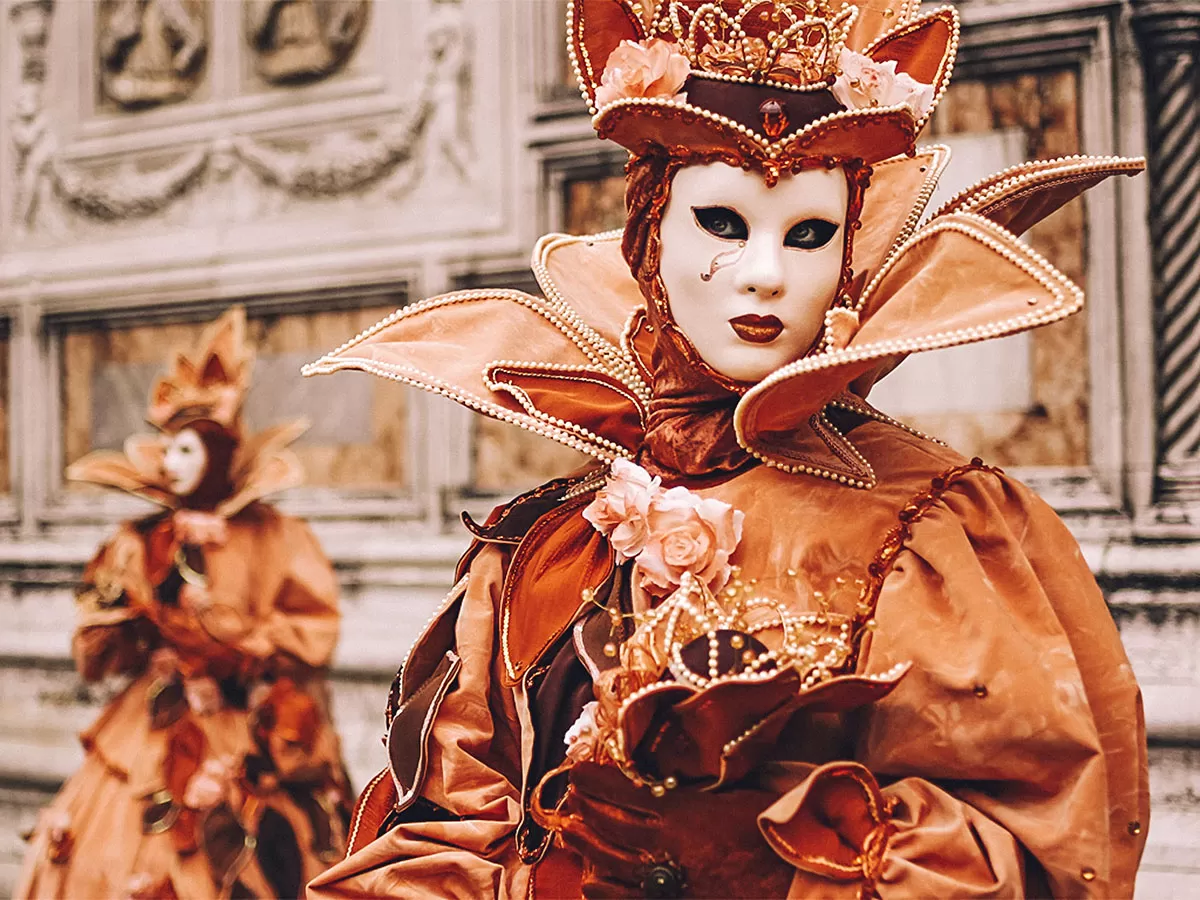 Carnival in Venice, with its dances, parties and public shows, reached its golden period in the eighteenth century when the Serenissima Republic (appellative for Venice) was considered the “magnet” of Europe. It achieved maximum splendour thanks to its transgressive atmosphere, international recognition, commedia dell’arte (a form of theatre), and famous characters like Casanova and Goldoni (an Italian playwright).
Carnival in Venice, with its dances, parties and public shows, reached its golden period in the eighteenth century when the Serenissima Republic (appellative for Venice) was considered the “magnet” of Europe. It achieved maximum splendour thanks to its transgressive atmosphere, international recognition, commedia dell’arte (a form of theatre), and famous characters like Casanova and Goldoni (an Italian playwright).
Unfortunately, the story of Carnival also has a sad chapter. In 1797 came the French invasion then later the Austrian occupation, together they ultimately put an end to not only Venice’s independence but also to Carnival. Celebrations were outlawed and the use of masks was strictly forbidden. Overall, this ban lasted for nearly 200 years! It wasn’t until 1979 that this ancient tradition was restored that can still be experienced today.
Don’t miss my Carnival guide below.
Venice Carnival today
Nowadays, Venice Carnival is back to being that hedonistic, prestigious celebration that it was when the Republic of Venice was the centre of the world, and one of Italy’s biggest events.
Venice Carnival runs for the two weeks leading up to Ash Wednesday. During this time a series of spectacular events such as masquerade balls, parties, parades, shows, and historical re-enactments take place in and around Venice.
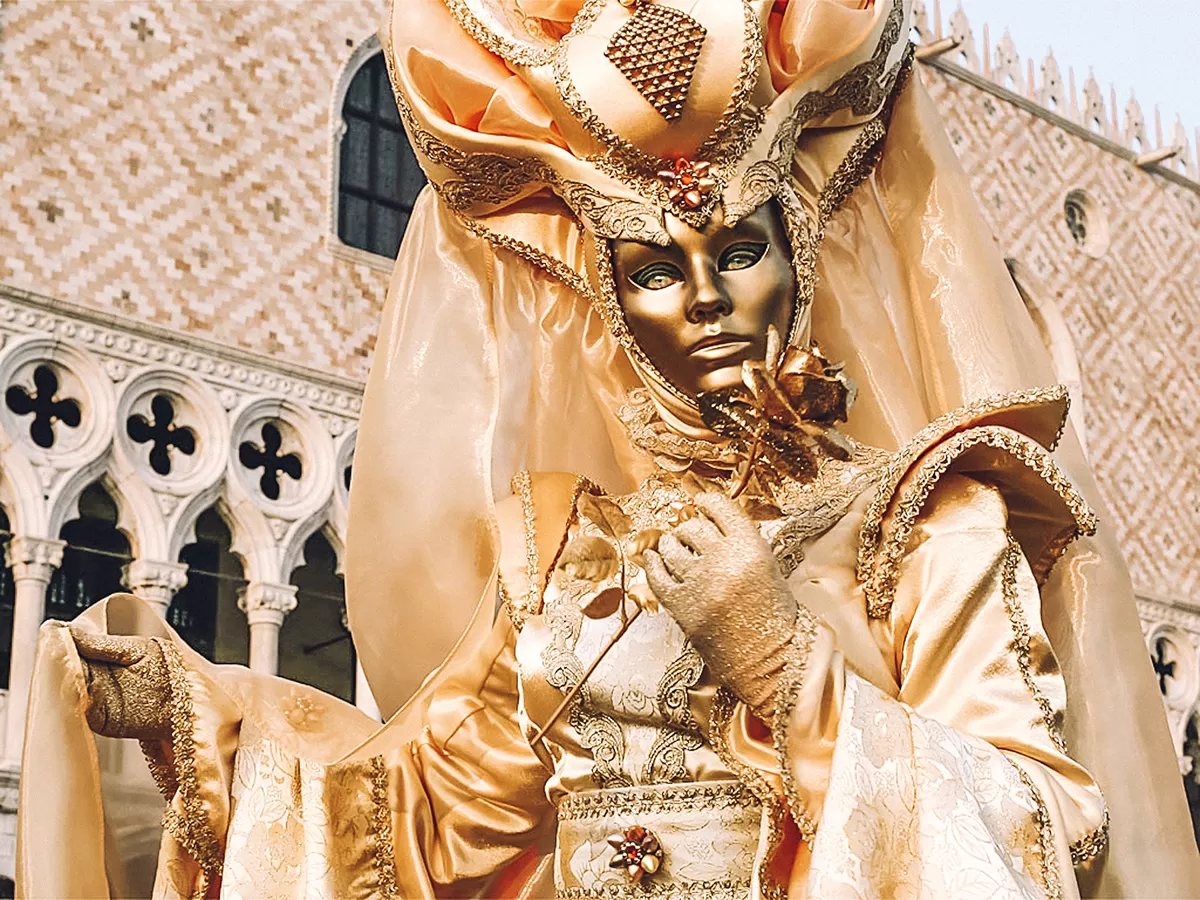
An enchanted atmosphere fills the streets and squares of Venice and locals and visitors from all over the world dress up wearing elaborate costumes and masks. You can attend private parties, masquerade balls or simply watch the performances and the historical re-enactments in public squares and along the canals and be transported back in time.
Traditionally, the most important days of the Venetian Carnival are Shrove Thursday and Shrove Tuesday, although the largest crowds are recorded during the weekends.
Charm, enthusiasm and magnificence are the keywords of this unique and special event.
Once-in-a-lifetime Carnival Experience
To get the full Carnival experience, you can’t pass up attending il Gran Ballo Mascheranda. Set in a stunning 18th-century palace overlooking the Grand Canal, this costume-only event guarantees a night of pure escapism. Set in a decadent hall, you’ll enjoy an aperitif on arrival, a 3-course dinner, and various theatrical performances and dancing until late. This once in a lifetime event is hosted by none other than Casanova! Various tickets options are available as well as costume hire. Reserve your ticket here.
Typical Carnival sweets
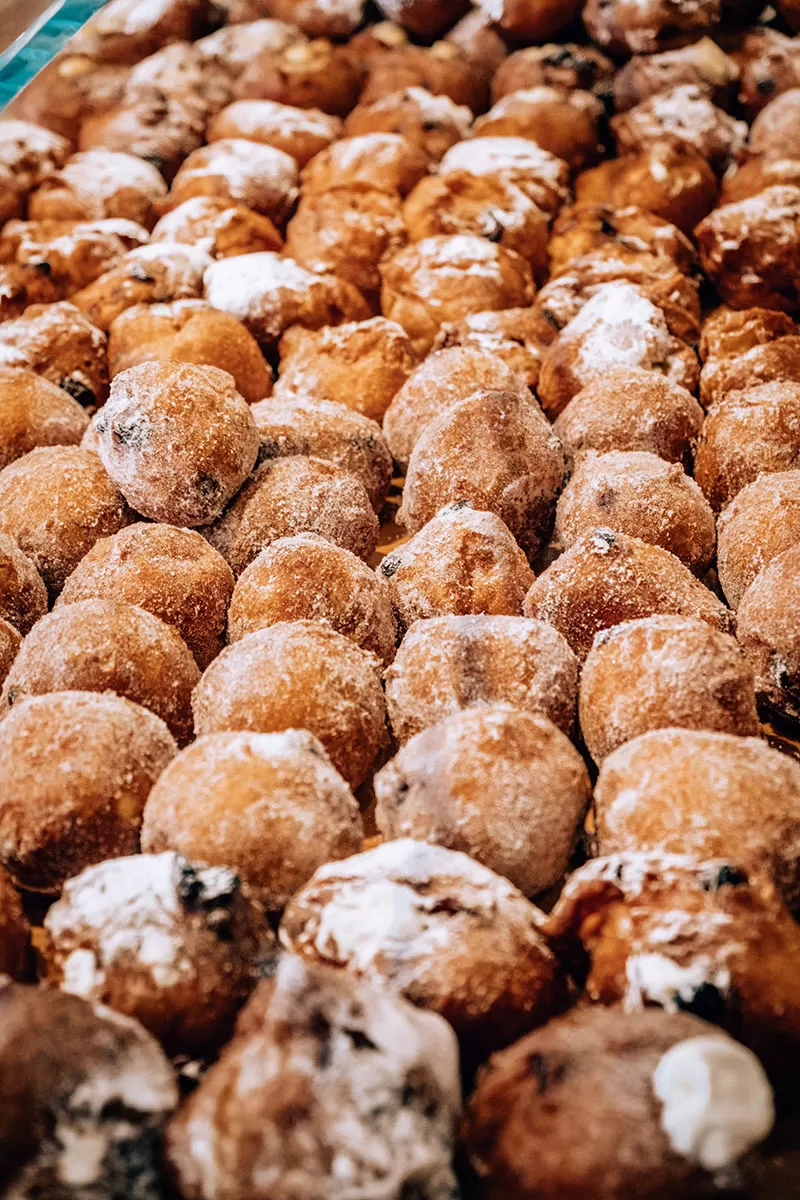 There is a Venetian proverb that says “Chi no le fa de Carneval, le fa de Quaresema” meaning, Those who do not do crazy things at Carnival, do them during Lent.
There is a Venetian proverb that says “Chi no le fa de Carneval, le fa de Quaresema” meaning, Those who do not do crazy things at Carnival, do them during Lent.
And what is Carnival without enjoying the pleasure of culinary delights? Even in the early years of Carnival, street vendors would sell all kinds of merchandise, often exotic too. From seasonal fruit to spices, the people of Venice could savour foods from distant countries where Venice had large trade routes, especially from the East.
Even today, after the Christmas holidays, store windows and family dinner tables are filled with all sorts of Carnival sweets. As per these traditional recipes, frying was the main cooking method because it allows for large quantities to be prepared quickly. Among these, there are: frittelle, galani (or chiacchiere) and castagnole.
Frittella (a sort of fried pastry) is most certainly the undisputed queen of Carnival and has remained practically unchanged from its original recipe. The “frittella alla veneziana” (Venetian style) contains raisins, pine nuts and sugar, however, many variations have appeared on the market such as with cream and apple mousse.
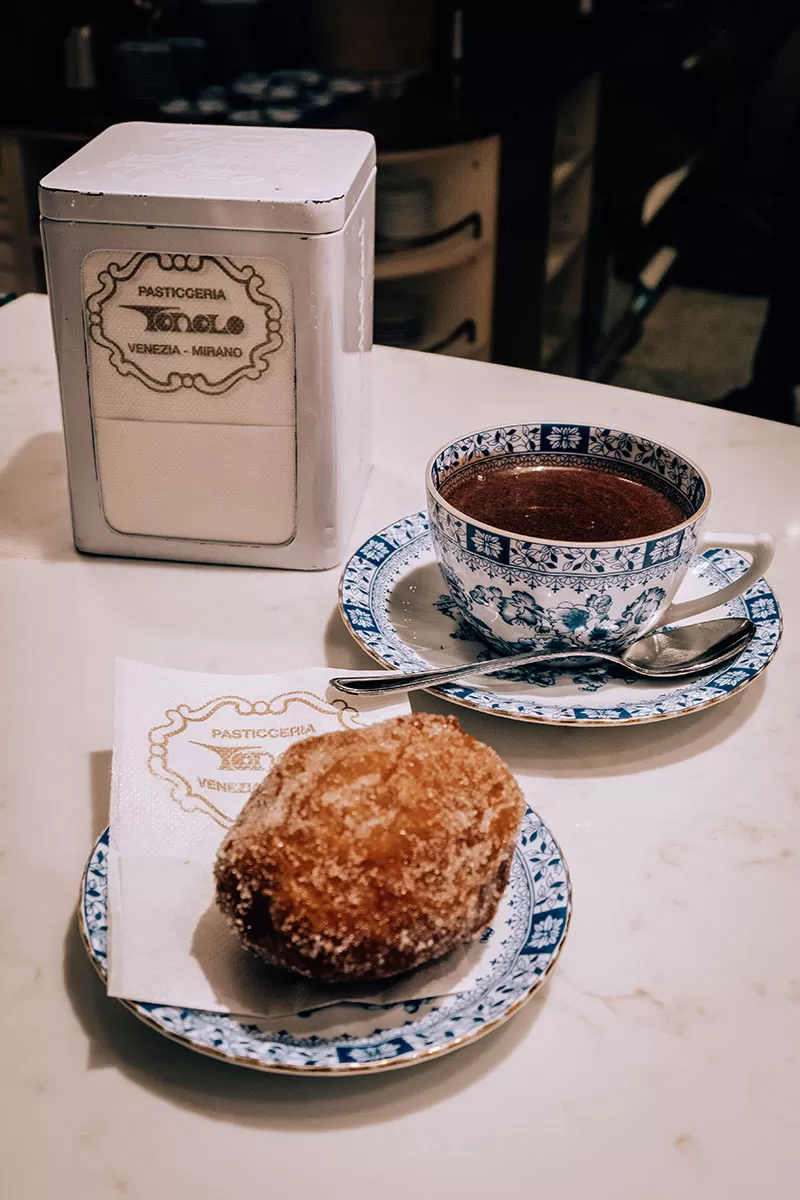
For the best Frittelle, visit Pasticceria Tonolo
Venice Carnival masks
Since its inception, wearing masks has been an essential feature and played an important role in Venice Carnival. Wearing masks was a way to hide personal identity, gender, social class and just become part of the Great Carnival Illusion in a place where anything can happen – where every glimpse never ceases to enchant.
Wearing masks was not just limited to Carnival but also worn on many other occasions during the year. For example, it was allowed on Stephen’s day during the fifteen days of the Ascension and for other important events of the Serenissima Republic.
During Carnival, Venetians would walk around the city wearing masks and greet others with a simple “Buongiorno, signora maschera!”.
To meet demand, mask production became a flourishing trade that soon became the hallmark of the city itself. To create Carnival masks, mascherari (mask makers) used all sorts of materials, from papier-mache, leather, porcelain to glass and decorated them with gems, feathers and fur. The very first ones were rather simple in design, style and decoration but over time they became more and more original, differentiating in many modern varieties and colours.
Among the most popular of Venice Carnival masks are the so-called Bauta masks, which cover the entire face but leave some space below for eating, drinking and talking. The Bauta was worn by both men and women. It is formed by a black veil or Tabarro, a black tricorn and a white mask.
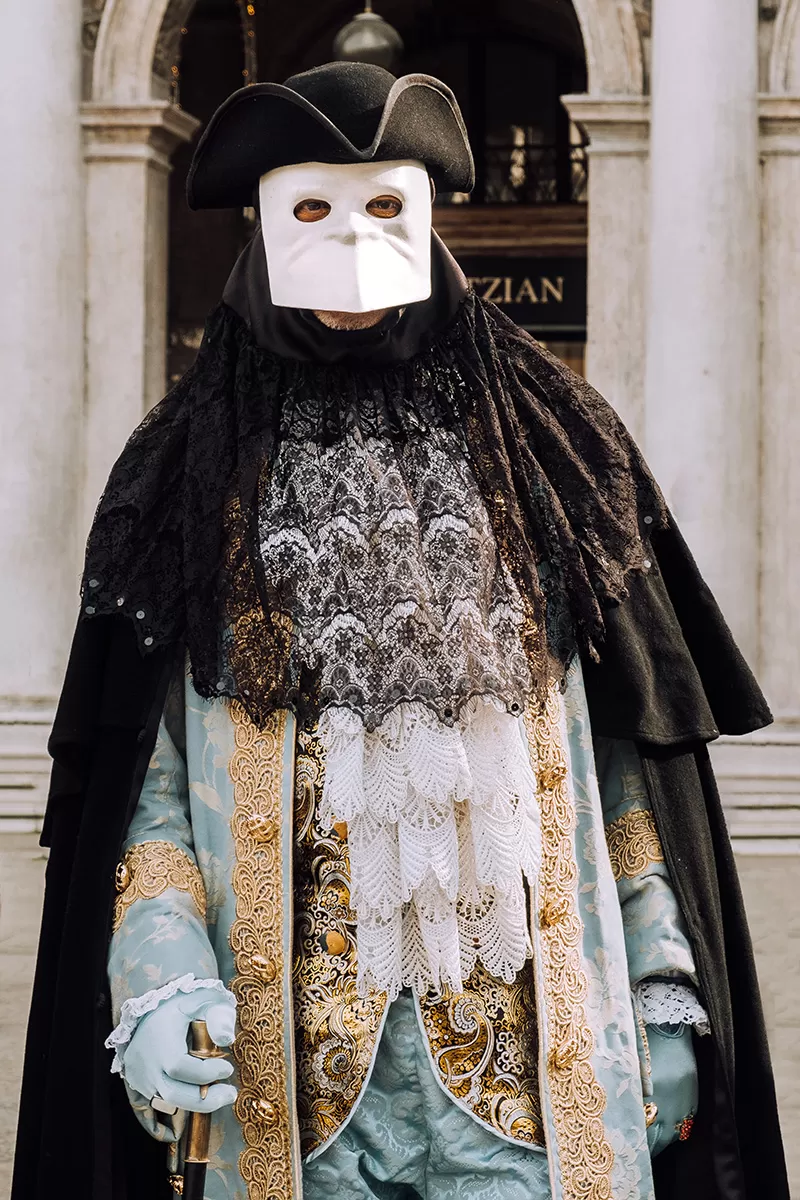
Bauta mask
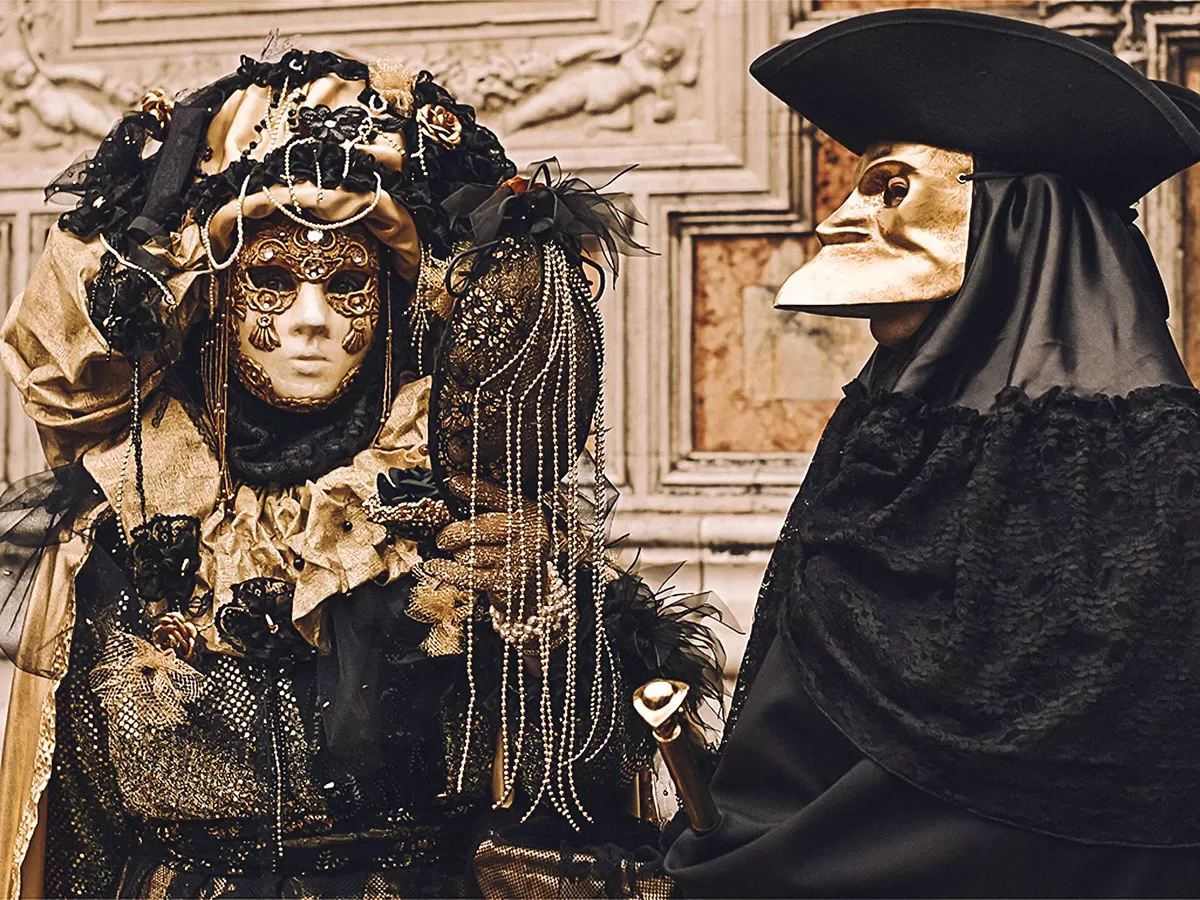
The Bauta Mask (right) is worn by both women and men
Another famous Venetian mask is the Moretta, an oval-shaped mask only worn by women. Made of dark velvet and worn with a veil, it was also called a “mute mask” since it was held in place by the mouth thanks to a small button inside.
The Volto mask is a plain white mask that covers the entire face and is often worn with a black hooded cape.
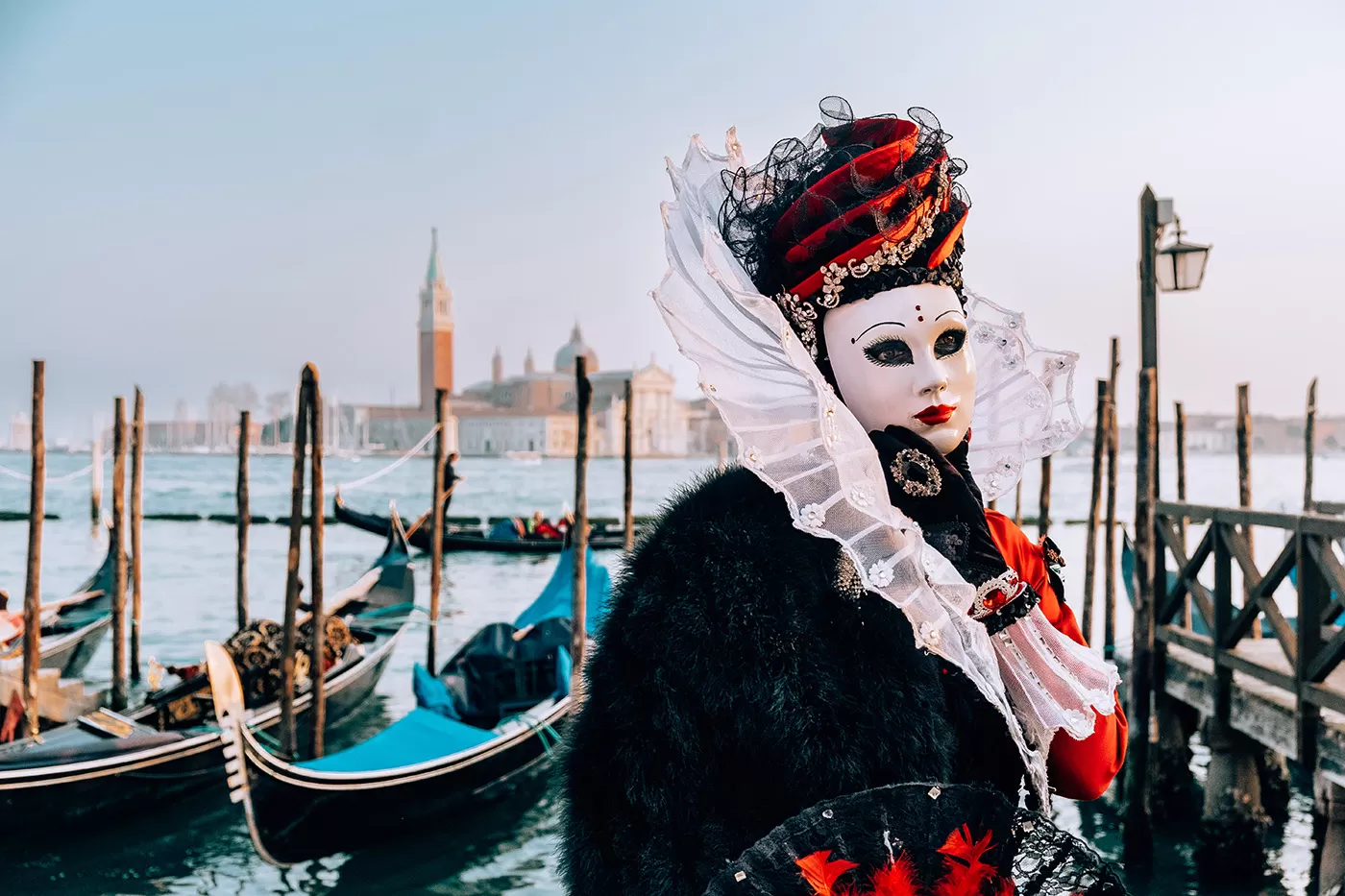
Volto mask
Other well-known masks and costumes are more colourful and festive and based on characters of the commedia dell’arte (first introduced by Carlo Goldoni in the 18th century) that speak of a past rich in inspiration and poetry. Among these include the greedy Pantalone (English: Pantaloon), the elegant Colombina (English: Columbine), and the colourful Arlecchino (English: Harlequin).
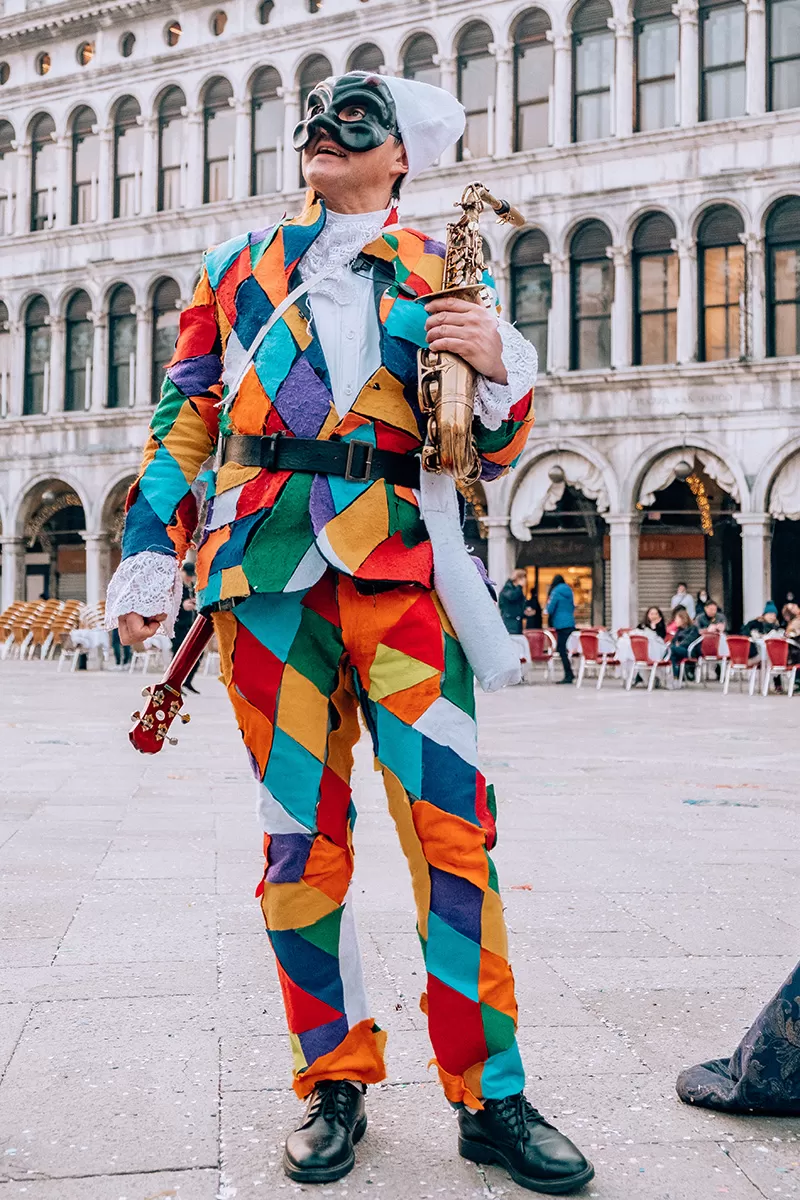
Harlequin costume from Commedia dell’Arte
Last but not least we have the infamous Plague Doctor. This unmistakable mask features a long-beak nose, glasses, a tunic made of either linen or waxed cloth and a stick to lift the clothes of plague victims.
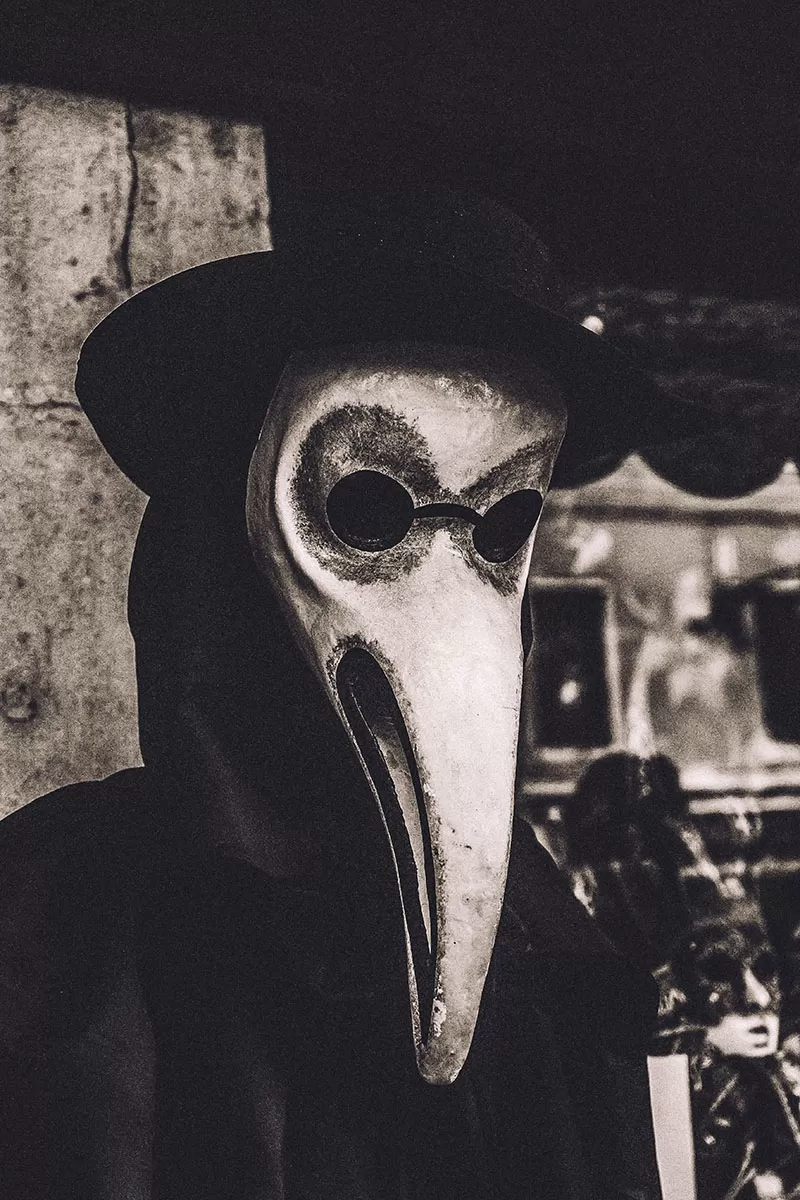
Plague Doctor mask
The Plague struck the city of Venice on several occasions and the Plague Doctor mask was actually worn for practical necessity as its long nose contained a kind of filter composed of salts and herbal disinfectants like rosemary, garlic and juniper. Later on, this mask acquired a superstitious and exorcist meaning that repelled any contagious disease and therefore it was kept in the ritual of Carnival.
Venice Carnival Events
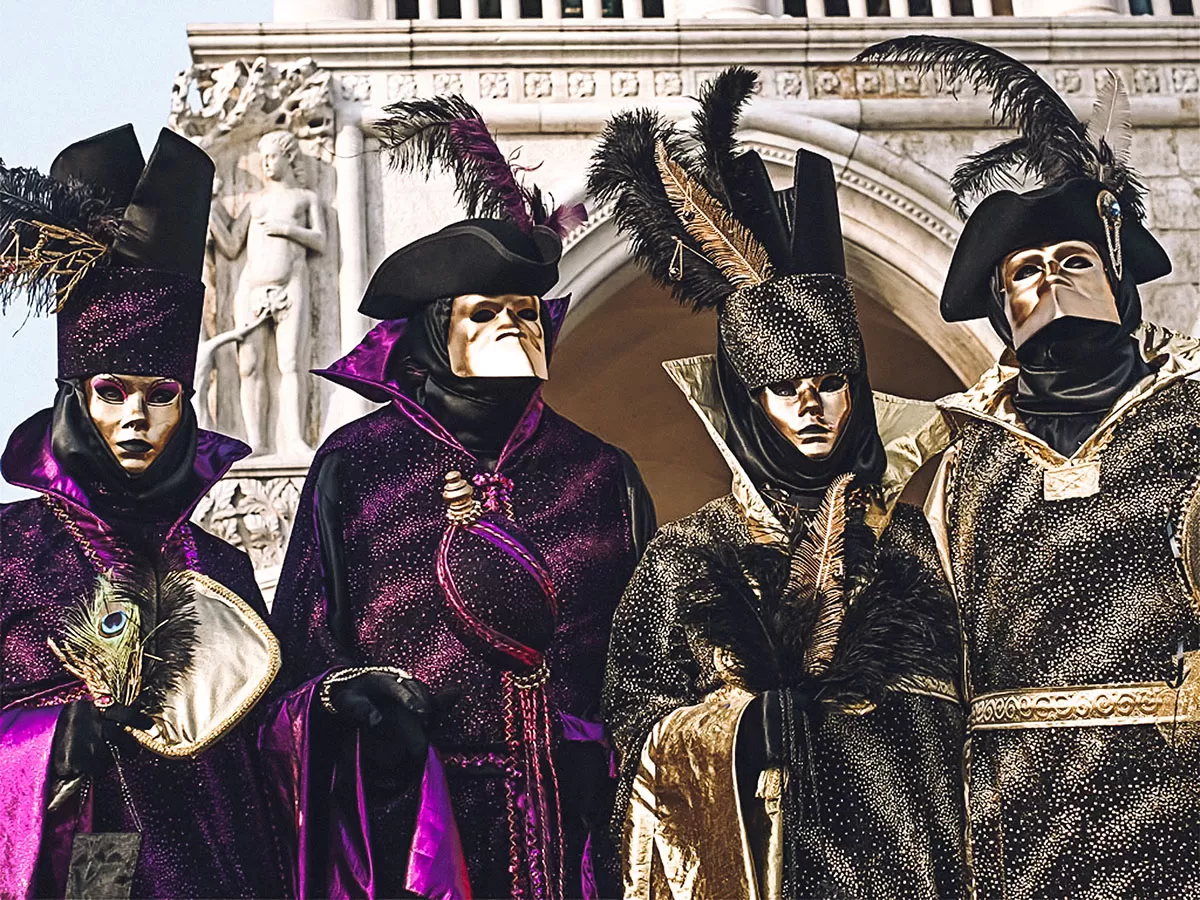 Let’s take a moment to explore the calendar of important events that take place every year at Venice Carnival. In 2022, the first event starts a couple of days before Valentine’s Day, on the 12th of February with the last event on March 1st. You’ll find names in both Italian, along with the English translation in brackets.
Let’s take a moment to explore the calendar of important events that take place every year at Venice Carnival. In 2022, the first event starts a couple of days before Valentine’s Day, on the 12th of February with the last event on March 1st. You’ll find names in both Italian, along with the English translation in brackets.
13th February 2022: Festa Veneziana sull’acqua
Event name: Festa Veneziana sull’acqua (Venetian Water Festival)
Location: Rio di Cannaregio, which was historically the main shipping canal in Venice.
To kick off Carnival, Festa Veneziana sull’acqua transforms this canal into a fantastic water stage putting on a spectacular show full of extravagante floating structures and acrobats performing impossible routines.
Located on the edge of Cannaregio (the most populated district of the city), this event is performed twice on the same day, once at 7 pm then again at 9 pm.
19th February 2022: Corteo e Festa delle Marie
Event name: Corteo e Festa delle Marie (Parade and Feast of the Marys)
Location: Via Garibaldi
The traditional ‘Festa delle Marie’ procession starts at San Piero di Castello at around 2.30 pm, continues along via Garibaldi and Riva degli Schiavoni before arriving on stage in Piazza San Marco around 4.00 pm, where the official presentation of Carnival takes place.
This historic re-enactment celebrates the Doge’s custom of giving gifts such as clothes and jewellery every year to 12 beautiful girls of humble origins, so that they would have a dowry when they get married.
In 973 AC, during one of these celebrations, Venice was attacked by pirates, and the brides were kidnapped along with their jewellery. They were miraculously saved and since then the city of Venice has made votive offerings to the Virgin Mary by officially establishing the Feast of the Marys.
Later on, carved wooden statues called ‘Marione’ replaced the actual girls and the festival lost much of its original meaning. In the following years, the celebration slowly fell into disuse and was suppressed in 1379. It wasn’t until 1999 that the modern celebrations of the ‘Festa delle Marie’ were re-established as a symbolic event.
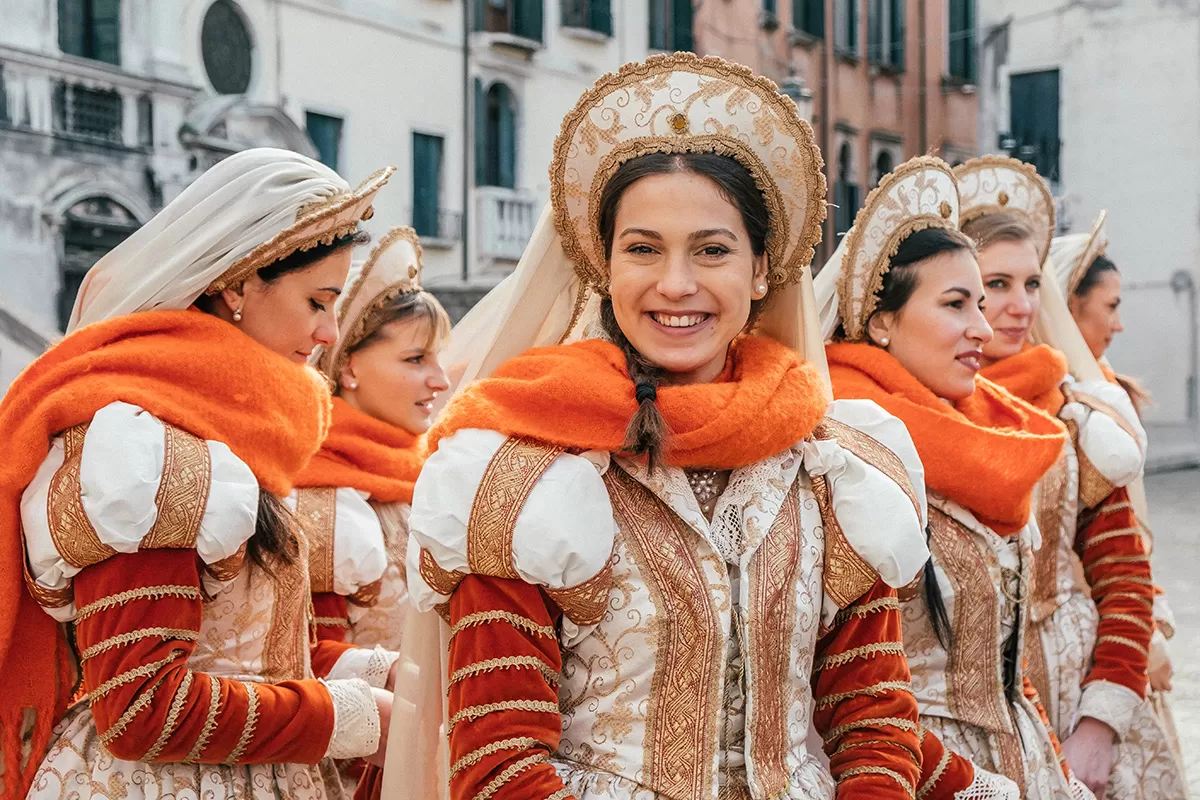
Festa delle Marie
20th February 2022: Volo dell’Angelo
Event name: Volo dell’Angelo (Flight of the Angel)
Location: St. Mark’s Square
Like many other traditions, the Volo dell’Angelo was re-established after a long period of absence. During a Carnival in the mid-sixteenth century, a young Turkish acrobat managed to reach the belfry of St Mark’s bell tower by walking on a very long rope. Aided only by a barbell, he began his ascent on a rope that was tied to a boat anchored at the nearby pier.
The event, which was immediately named Svolo del turco (Fly of the Turk), aroused so much interest that the Venetians asked for it to be repeated in the following editions of Carnival. It usually took place on Shrove Thursday (while today it takes place on the second Sunday of the Carnival period), and underwent numerous variations over the years.
In 1759, the performance ended in tragedy where the acrobat plummeted to the ground amidst the horrified crowd. Due to the seriousness of this accident, the act of ascension by rope was banned. From then on, a large wooden dove (in Italian: “colomba”) was used in place of the acrobat. The dove released flowers and confetti onto the crowd as it flow from the bell tower. The “Volo dell’Angelo” (Flight of the Angel) then became the “Volo della Colombina” (Flight of the dove).
The original event has only very recently been revived. The first “modern” edition dates back to 2001. At first, the role of the “Angel” was entrusted to famous people in the field of sport or show business but since 2011 the task has been assigned to the winner of the previous year’s “Marie” competition.
27th February 2022: Il Volo dell’Aquila
Event name: Il Volo dell’Aquila (The Flight of the Eagle)
Location: St. Mark’s Square
Il Volo dell’Aquila is one of the most recent traditions of the Carnival of Venice. The Flight of the Eagle was established in 2012 in addition to the popular Flight of the Angel. During this event a similar aerobatic flight is performed by a prominent sports figure who soars over the festive crowds gathered in St Marks’ Square below.
Some of the previous editions included ice skaters Carolina Kostner and Arianna Fontana, the alpine skier Kristian Ghedina, and the Paralympic athlete and TV presenter Giusy Versace.
27th February 2022: Finale del concorso La Maschera Più Bella
Event name : Finale del concorso La Maschera Più Bella (Final of The Most Beautiful Mask contest)
Location: St. Mark’s Square
This contest is judged by a panel of international costume and fashion designers. For the 2021 edition, the winning masks included “La medichessa della Peste” (The Plague female Doctor), which best interprets the current period we are living in. During the whole Carnival period, every day the jury votes for the most beautiful masks and the winners will go directly to the final.
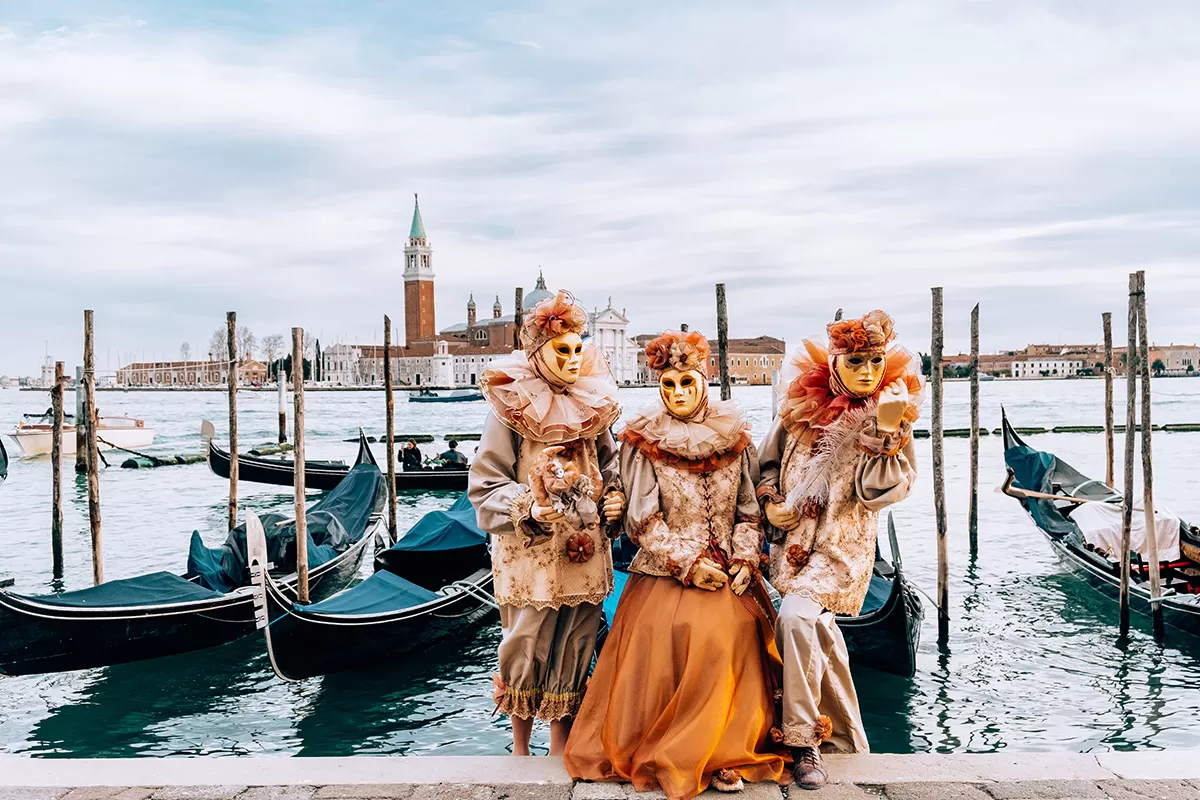
28th February 2022: Concorso La Maschera Più Bella – edizione per bambini
Event name: Concorso La Maschera Più Bella – edizione per bambini (The Most Beautiful Mask Contest – children’s edition)
Location: St. Mark’s Square
Similar to the adult version, this is a lovely event where children can actively participate in the festivities.
1st March 2022: Premiazione della Maria del Carnevale
Event name: Premiazione della Maria del Carnevale(Award ceremony of the Carnival Mary)
Location: St. Mark’s Square
On the last day of Carnival celebrations, there is an award ceremony that crowns the winning “Maria”. The event takes place after a water parade that starts at San Giacomo dell’Orio ends at the square’s edge. The winning Maria will then return the following year to play the role of the angelo, in the Flight of the Angel ceremony.
1st March 2022: Svolo del Leon
Event name: Svolo del Leon (Flight of the Lion)
Location: St. Mark’s Square
To bid Carnival farewell, a huge flag with St Mark’s winged lion is symbolically hoisted to the top of the Campanile (bell tower). Accompanied by effects and music, this event pays homage to the city, its history, and traditions through its most representative symbol: the Leone (lion) of St Mark. This marks the official closing of the past two weeks of celebrations and excitement with a promise to return the following year.
Planning a trip to La Serenissima? Don’t miss my guide to the most unique and best things to do in Venice.
Carnival vocabulary list
Now that you know all about Carnival’s history, masks, culinary delights, masks and events, let’s brush up on some essential vocabulary.
| Italian word | English translation |
|---|---|
| La maschera | Mask |
| Il costume | costume |
| Travestirsi | To dress up |
| Indossare | To wear |
| Gli eventi | Events |
| Il ballo | Ball |
| Il ballo in maschera | Masquerade ball |
| Il corteo | Parade |
| La festa | Party, feast |
| Il volo | Flight |
| L’angelo | Angel |
| I festeggiamenti | Celebrations |
| Le rievocazioni storiche | Historical re-enactments |
| La gara | Competition |
| Il concorso | Contest |
| La premiazione | Awarding |
| La Quaresima | Lent |
| Il Martedì grasso | Shrove Tuesday |
| Il Giovedì grasso | Shrove Thursday |
| Il digiuno | Fasting |
| Il medico della peste | Plague doctor |
Venice has given us so many words that we use every day in English. Here are 14 Venetian words you never knew came from Venice.
Conclusion
Even though the Carnival of Venice is no longer celebrated for the same reasons that brought about its creation and has undergone several modifications throughout the years, it still remains an unmissable and remarkable event that should be experienced at least once.
Loved by locals and visitors from around the world, Venice Carnival is a unique opportunity to relive a fascinating time in history and experience the city through a historical lens.
Do you want to collect lifetime memories and soak up events of all sorts in the beautiful Venetian frame? Then come to Venice Carnival and enjoy Italy’s biggest party of the year!
Don’t be treated like a tourist. Learn Italian with my 80/20 method
Travelling to Italy? Don’t be treated like a tourist! Live your best travel experiences and learn Italian for less than the cost of eating at a tourist trap restaurant or a taxi driver who has “taken you for a ride”. I’ve made it easy for you to master the Italian language so you can create lifelong memories as you mingle with locals, get local tips, avoid tourist traps, and make new friends. Who knows, you may even be invited over for afternoon tea by a lovely Sicilian family like I was! Read all about how speaking Italian changed my life and check out my online Italian video course here.
Here’s what my students are saying:

I really enjoyed the Intrepid Italian course, it certainly exceeded my expectations. The learning methodology is great, and easy to follow and found that I progressed much faster in the last 4 weeks than I ever did on my own or using other language apps. Grazie mille Michele, I can’t wait until I can put my new skills into action! – Roma Small
Click here for instant access!
Don’t miss these Italy travel guides
- 33 Italy Travel Tips That Will Save You Time, Money and Disappointment
- 21 Unique Things to Do in Venice You Should Try at Least Once
- Rome Tips and Tricks: 27 Things You Should Know Before You Go to Rome
- Top 10 Things to Do in Rome That Aren’t On Your List
- Top 10 Absolute Best Views of Rome That Will Blow Your Mind
- Domus Aurea: Visit Rome’s Secret Hidden Palace
- Self-Guided Trastevere Walking Tour: Where to See Rome’s Most Beautiful Streets
- Absolute Best Things to do in Verona, Italy | 26 Must-See Attractions
- Top 7 Authentic Tours and Experiences in Rome [Run by Locals]
- Lakes, Mountains & Castles: 21 Best Things to do in Trento, Italy
- Italy Fun Facts: 126 Unique Things You Didn’t Know About Italy
Like it? Pin it for later!
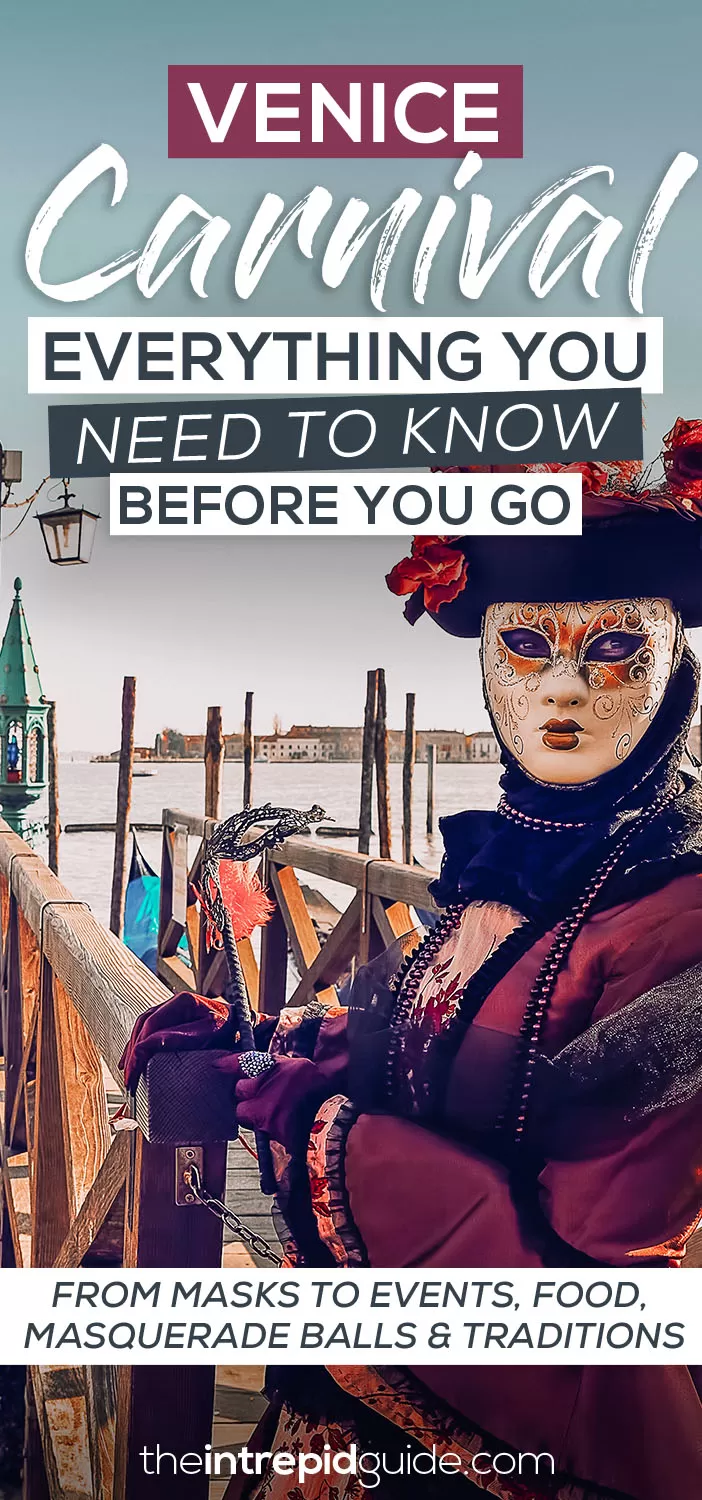
Over to you!
Did you find this guide helpful? Got a question? Let me know using the comments section below or join me on social media @intrepidguide or @intrepiditalian to start a conversation.
Thanks for reading and I hope you enjoyed this post.
Like what you see? Subscribe using the form below to have all of my posts delivered directly to your email.

